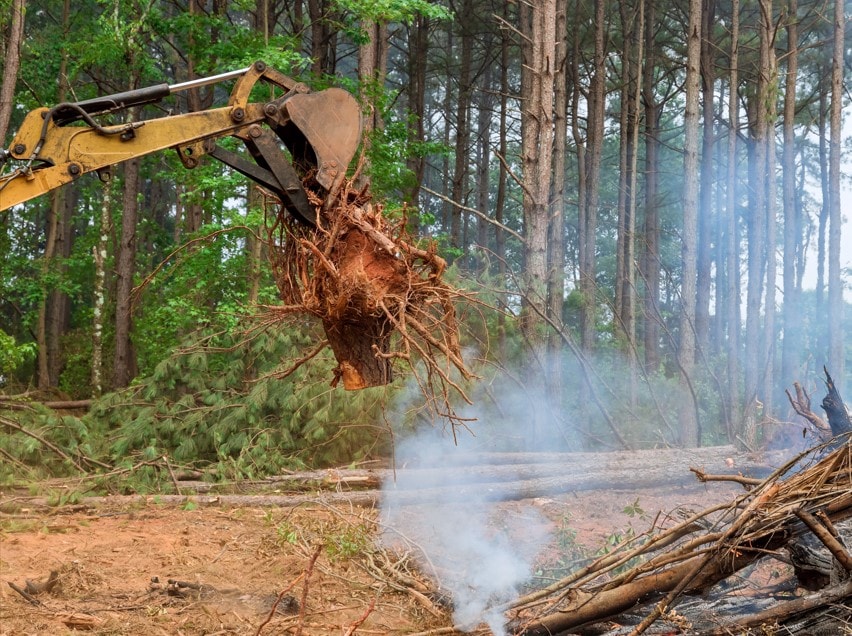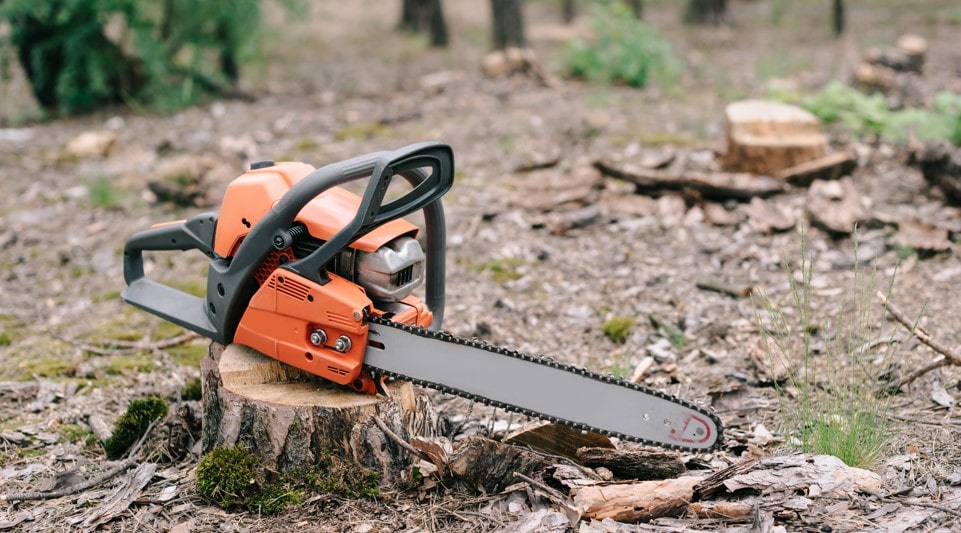- Best Stump Grinder Replacement Teeth - September 25, 2022
- How to Find the Best Log Splitter Wedge - September 11, 2022
- How to Find the Best Portable Winch for Logging - September 11, 2022
When we moved into our current home, the previous owner had done the bare minimum for maintenance. When the state did inspections and required every property owner to remove trees based on the inspection results to prevent massive fires, that same owner had paid some random Joe she knew to cut the branches off the trees that were a violation.
Let me be very clear: the state government paid for inspectors to verify things like trees that were too close together, trees that were touching electrical wires, trees that were touching the house, or dead trees that were close to falling. I have a copy of the report.
So instead of removing a smaller tree with branches touching the roof, she simply paid someone to cut off the branches in question.
In the rare case that she couldn’t get away with that, she had them cut down the tree but left all the pieces just sitting on the property around all the stumps.
When I moved in, the tree stumps littering the property were well on their way to formatting tiny bushes of new growth, and all the trees whose random branches had been removed were now dangerously uneven and leaning to one side.
The very first windstorm broke the trees. It wasn’t long before we had to call in a professional, and I decided it was easier to have the tree stumps removed simultaneously.
That is when I learned that the cost of removing tree stumps is usually much more expensive than the cost of removing the tree itself or, in her case, having just a few limbs cut off and left in place.
Bottomline Upfront
The national average for stump removal cost is $326 per stump. Your costs are broken down by how many stumps you need to be removed, how big the stumps are, what method is used, how hard it is to reach the stumps, and how complex the root system is.
Expect to pay an hourly wage between $94 and $163 per hour for all work done to remove your stumps.
Stump Removal Cost Pricing Guide: Where Does it Cost the Most?

The national average for stump removal cost is $326. However, the low end of that range is around $175 and extends all the way up to $516.
One of the biggest factors influencing the difference in cost depending on where you live is the local economy and what a professional will charge. Stump removal costs are typically based in large part on an hourly rate for tree care companies.
Tree care companies charge between $94 and $163 per hour.
| City | Average cost for homeowners |
| Las Vegas | $322-$446 |
| Oakland | $830-$1,150 |
| Philadelphia | $719-$1015 |
| Boston | $699-$965 |
| Cleveland | $393-$587 |
| Colorado Springs | $524-$698 |
| Kansas City | $442-$636 |
| Fort Worth | $372-$520 |
| Wichita | $531- $807 |
| Seattle | $536- $758 |
If you have more than one tree stump removed simultaneously, you typically get a reduced rate for all subsequent stumps beyond the first, between $40 and $83 per hour.
Stump Removal Cost Pricing Guide: What Influences Cost?
There are half a dozen things that can influence the cost of your stump removal like the method used, the hourly rate for the labor, the accessibility, the type of tree, whether you need a permit, how many stumps are being removed, and any other preparation or clean up that is required.
Removal Method
Let’s start with the removal method. I already talked about the hourly rate for labor, and the type of removal method used will greatly influence how much labor is required.
Stump Grinding

Grinding is the most cost-effective because they usually charge you an hourly rate and a rate based on each diameter inch.
For example: If the stump is 12 inches in diameter, you might pay $42; if it is 18 inches in diameter, you might pay $63, $84 for something 24 inches in diameter, or $105 for something 30 inches in diameter.
Stump grinder technicians use a large bladed cylinder and grind the stump down, about six inches below ground level. This process can take a couple of hours, depending on the stump’s size. You have to fill in the hole when you’re done.
This can’t be used in any situation where you have rocky soil, or the stump is hard to get to.
Continue reading related stump grinder guides and reviews:
Manual Removal
Manual removal is exactly what it sounds like: a professional comes in and uses tools like shovels, chainsaws, and axes to pull the stump and its roots out of the ground.
Many people avoid paying for this particular remove bold method because it costs the most, but if you plan to use that area for any type of gardening, landscaping, or foundation, this is your best method. It is the most effective for removing a stump thoroughly.
Burning

Burning isn’t an option where we live. You can only do it if you live in a very low fire risk area. You can’t do it yourself. It requires a permit and a local contractor.
For this process, a company drills holes into the stump fills it with potassium nitrate (the same compound used for chemical removal), sets it on fire, and lets it burn over the course of several hours. The team has to remain on-site to monitor all the sparks and embers because it does create a large, smoldering pit. You will have to deal with a lot of smoke, and there is a fire risk.
Chemical Removal
Chemical removal is an option, but I advise against it because it pollutes the environment, poses a risk to wildlife, can contaminate your soil, and won’t work well if you have a larger tree with a deep root system like we have.
With chemical removal, a company applies potassium nitrate to the area to try and soften the wood before removing it. But this won’t work well on deep root systems, as I mentioned, and it can be detrimental to any wildlife in the area, your pets, or your children. It also makes it such that you don’t necessarily want to use that area or any type of garden thereafter.
Size

Not all stumps are the same size. When I asked for a quote to remove five tree stumps, they asked me to go out and measure the approximate size for each diameter. Two of our tree stumps were around 36 inches, another was quite small at about 14 inches, but the last two were over 70 inches in diameter.
Most companies give you a price based on their hourly wage, but they’ll also set a minimum price, around $100, no matter the size. Consider this minimum the fifteen-minute increments an attorney would charge for their services. Smaller trees simply don’t take as much work to remove, even if you’re using the manual removal method.
- Small tree stumps up to 1 feet in diameter typically cost between $30 and $60 for removal.
- Tree stumps up to 2 feet in diameter will cost between $50 and $118.
- Larger tree stumps up to 3 feet will cost anywhere between $75 and $180 for removal.
- Tree stumps with a 4 feet diameter can cost up to $240 to remove.
- Tree stumps 5 feet in diameter or more will cost $300 on average to remove
Accessibility
Some of the stumps we had removed were on a flat patch of land, but the rest were on a steep hill, so the people we hired had to be a little more careful about their tools, equipment, and methods.
For example: They couldn’t burn it down because that wasn’t allowed in our state, and the area was very rocky, so a grinder was a no-go. That left manual removal as the only available method, and manual removal meant hours of chainsaws, axes, and hand tools while the team precariously balanced themselves on the steep gradient.
This just meant it cost a lot more because we had to pay per hour.
The accessibility of the stump will influence the cost and the removal method you can use because it directly influences:
- How accessible it is,
- How complex the root structure is,
- How labor intensive it is,
- What tools and level of labor are required.
The Type of Tree

The type of tree plays a role in your cost. We had a lot of oak and a walnut tree. Because they were harder woods, it took more effort for the company to remove them, and that meant a higher cost.
You can expect to pay a bit more for hardwood like:
- Oak
- Cherry
- Walnut
- Hickory
- Elm
- Maple
Permits
In some situations, permits are required to remove a protected tree. For example, in Oakland, a live oak bigger than four inches in diameter and taller than four feet requires a permit.
Quantity
As I mentioned, most companies are happy to give a reduced hourly rate if you have more than one stamp to remove. A big part of this is because the preparation and cleanup can be done all at once, and it can be faster to use the same tools replicated across multiple stumps rather than coming back on separate occasions.
Preparation and Cleanup

When we had our stump removal, I already explained that they had been left to regrow and had converted into small bushes. So, the tree removal professionals had to prepare the area by removing the new growth. They also had to remove many of the rocks around the stumps.
Putting in this prep work meant things like chainsaws didn’t accidentally connect with a rock and break the blade or send pieces of rock shrapnel flying through the air.
We also had to pay extra for them to haul away not only what has left behind from the stump removal but all the pieces that had been left behind from the previous tree felling. Depending on the method you use, if there are wood chips, sawdust, or mulch left behind, the tree service will likely haul them away for you, but they’ll charge extra.
A lot of this comes back to that hourly rate and the fact that each hour spent preparing an area and cleaning up after a stump removal will contribute to the cost.
FAQs
Question: Does stump removal get rid of the root system?
Answer: This depends on the removal method. Manual removal will likely get rid of the root system, but most companies charge $100 to $200 per hour to remove the root system after felling the trees and/or removing the stumps. Commercial grinders have attachments that remove roots, but the company has to have that attachment and spend the extra time getting rid of more complex root systems.
Question: Will it cost more for stump removal in rocky soil?
Answer: This depends. The cost can increase by 50% or more if you have a particularly rocky landscape. Our property was set on a steep gradient with lots of large boulders, some of which are the size of a couch. This affected the cost.
However, if you live in an area where everybody has rocky terrain, it’s unlikely that you will see an increase in the cost because of that; professionals who work in those areas have already taken that into account and padded their hourly rates to accommodate the local soil conditions.
Question: Is grinding or removing a stump easier?
Answer: Grinding is faster and easier, and then you can mulch the stump, but that doesn’t actually remove the root system, so you can’t really build on the area or plant anything where the tree once was. You also have the risk of a mulching, decaying tree stump bringing pests and fungi to your area.
Manually removing will cost you more, but it also removes the root structure, so you don’t have any type of decay, and you free up the use of that space.
Question: When do I have to remove a tree stump?
Answer: Whenever you fell a tree, you should remove the stuff. Don’t do what our previous owner did and leave them to wait a few years. It will cost you more money long-term if you wait and then have someone remove the stumps later.
A stump may or may not decay on its own, but it can take at least a decade. There are ways to expedite this process by burying the stump in wood chips and mulch, but a decaying tree stump will bring pests and other problems to your yard, which can be a serious risk for children and pets, not to mention your garden.
Question: Can I just remove stumps myself?
Answer: Yes, there’s nothing stopping you from removing a stump yourself. But on average, it takes at least three hours, and you’ll have to rent a hydraulic stump grinder or similar machinery, depending on the method you want to use.
If you rent any type of machinery, you typically have to pay either in half-day or full-day increments, so you have a time limit, and you usually are on the hook for a deposit. You also have to consider the amount of time you spend going to and from nearby stores to rent the equipment, the gas you spend, and your level of expertise when it comes to removing a tree stump.
I know from personal experience that every attempt to save money and do tree work myself only resulted in a huge deficit, a waste of a weekend, lots of unnecessary curse words, and finally giving in and calling a professional the next week.
Bottomline
The national average for stump removal cost is $326 per stump, but the rates drop a bit if you have more than one removed at the same time.
The method used to remove the stump, how easy it is to reach the stump, how complex the root system is, and how big the stumps are will influence how much you are charged.
Most of the cost per stamp is broken down based on an hourly wage for the professionals involved in the stump removal process.

